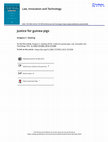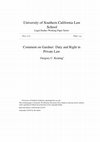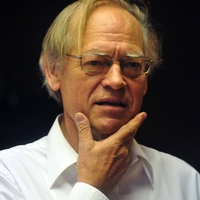Papers by Gregory Keating

Journal of Tort Law, May 21, 2021
Instrumentalist ideas have long been prominent in torts scholarship. Since the rise of legal real... more Instrumentalist ideas have long been prominent in torts scholarship. Since the rise of legal realism, discussions of deterrence, compensation, the minimization of accident costs, and the distribution of losses, have dominated scholarly discourse. In the past several decades, however, wholesale rejections of instrumentalist tort theory have arisen. The most uncompromising of these views rallies around the avowedly formalist battle cry that tort is “private law”. Ernest Weinrib’s elegant and influential book, The Idea of Private Law declares its allegiance to that thesis in its title, and the idea figures almost as centrally in Arthur Ripstein’s recent and important Private Wrongs. Theorists who rally around the banner of “private law” claim that tort law’s governing principles of right and responsibility tumble out of the field’s characteristic legal form. Law, as they understand it, is constitutive of just relations among persons, not an instrument for the pursuit of independently valuable ends. For scholars like Weinrib and Ripstein, “private law” is the Kantian idea of reason that makes our actual law of torts intelligible.
The claim that torts is a law of wrongs where persons bring claims in their own names for harms that they have wrongly suffered against those allegedly responsible for those wrongful harms is powerful and persuasive. The claim that the obligations persons owe one another in tort are obligations owed among equal and independent persons is likewise compelling. But theorists of tort as “private law” overshoot the mark by both asking and making too much of form. They ask too much of form when they attempt to make sense of the private law of torts solely in terms of form—eschewing all talk of interests. We cannot understand or justify the law of torts without attending to the interests that it protects. In tort, as elsewhere, rights and the duties they ground protect important individual interests. For example, it is our interest in the physical integrity of our persons that grounds the law of negligence. Theorist of tort as “private law” make too much of form when they present the legal category as its own private fiefdom walled off from surrounding legal fields. For Ripstein and Weinrib “private law” is its own autonomous domain, sealed off against infection by any legal field whose form identifies it as “public law”. In our law, the private law of torts cooperates and competes with public law institutions as a response to the pervasiveness of accidental harm in an industrial and technological society. It is one way of institutionalizing our interest in safety.
Establishing rightful relations among free and equal persons in civil society requires that institutions protect persons’ urgent interests, not just establish their formal independence. The theoretical understanding that we need will recognize that we misunderstand even the private law of torts itself if we sever it entirely from forms of collective responsibility for avoiding and repairing accidental harm with which it competes and cooperates.

University of Southern California Legal Studies Research Paper Series, 2015
This paper responds to Benjamin Zipursky’s Reasonableness in and out of Negligence Law 163 U. PA.... more This paper responds to Benjamin Zipursky’s Reasonableness in and out of Negligence Law 163 U. PA. L. REV. 2131 (2015). It takes issue with Professor Zipursky’s aversion to the Hand Formula. Trying to write the Hand Formula out of negligence law at this late date is tantamount to repudiating one hundred years of tort law and theory. This revisionary theorizing is as unnecessary as it is quixotic. The Hand Formula is not only too deeply embedded in negligence law to uproot; it is also unobjectionable. Indeed, the Hand Formula is one of modern negligence law’s more important achievements. It frees the concept of due care from a disturbing identification with customary practice and ties due care more closely to the idea of justified conduct. By doing so, it gives negligence law an important critical dimension.The Hand Formula draws its appeal from two sources. First, it is an exemplary instance of a court distilling the implicit essence of a body of case law. Second, the considerations ...

Civil Wrongs and Justice in Private Law
This chapter contends that modern tort law is not “private law” in the distinctive way in which t... more This chapter contends that modern tort law is not “private law” in the distinctive way in which that term is now used. Theorists of tort as “private law” tend to regard its domain as one-off collisions among individual persons as they pursue their particular purposes, each in his or her individual, idiosyncratic, and voluntary way. Modern tort law, however, emerged in response to the rise of accidental harm as a pressing social problem. This chapter argues that refocusing on accidental harm as a basic feature of an industrial civilization prompted tort law to undergo a significant but underappreciated transformation in which harm is as salient as wrong and conceptions of collective responsibility compete with individual responsibility for control of the field. Trenchantly challenging the most basic commitments of the Kantian conception of tort law championed by Ernest Weinrib and Arthur Ripstein, this chapter maintains that there is nothing fundamentally private about tort law.

Journal of Tort Law
Contemporary tort theory is a contest between instrumentalism and formalism. The prominence of in... more Contemporary tort theory is a contest between instrumentalism and formalism. The prominence of instrumentalism is no surprise. American tort theory was born in the work of Oliver Wendell Holmes and his views were resolutely, if elusively, instrumentalist. Until very recently, economic views have dominated contemporary discussions of tort law in the American Legal Academy, and the economic analysis of torts is uncompromisingly instrumentalist. The rise of formalism, by contrast, is surprising. Legal realism swept over American legal thought long ago. Ever since, formalism has been treated more as epithet than as credible position by American legal scholars. In contemporary tort theory, though, formalism has roared back to life and struck some powerful blows against instrumentalism. Tort, these neo-formalists argue, is not an instrument for the pursuit of independently valuable ends. It is an institution whose norms are constitutive of just relations among persons. The bipolar, backwa...

The Oxford Handbook of the New Private Law
This chapter discusses the concept of corrective justice, which has been at the heart of much rec... more This chapter discusses the concept of corrective justice, which has been at the heart of much recent scholarship on the law of torts in particular and private law more generally. Notwithstanding its familiarity, ancient origin, and apparent universal acceptance, the concept of corrective justice has produced a remarkable number of distinct conceptions and has stirred up major controversies. For at least a generation, corrective justice stood at the center of the argument between contending conceptions of tort. For legal economists, corrective justice was an aspect of the institution of tort law. It was part of the data that needed to be explained and justified in economic terms. Corrective justice was subordinate. It was a feature of—not a justification for—the institution of tort law. For legal philosophers Ernest Weinrib and Jules Coleman—who championed corrective justice as the countertheory to economic analysis—corrective justice was sovereign. It was both instantiated in the in...

Journal of Tort Law, 2021
Instrumentalist ideas have long been prominent in torts scholarship. Since the rise of legal real... more Instrumentalist ideas have long been prominent in torts scholarship. Since the rise of legal realism, discussions of deterrence, compensation, the minimization of accident costs, and the distribution of losses have dominated scholarly discourse. In the past several decades, however, wholesale rejections of instrumentalist tort theory have arisen. The most uncompromising of these views rallies around the avowedly formalist battle cry that tort is “private law”. Ernest Weinrib’s elegant and influential book, The Idea of Private Law, declares its allegiance to that thesis in its title, and the idea figures almost as centrally in Arthur Ripstein’s recent and important Private Wrongs. Theorists who rally around the banner of “private law” claim that tort law’s governing principles of right and responsibility tumble out of the field’s characteristic legal form. Law, as they understand it, is constitutive of just relations among persons, not an instrument for the pursuit of independently v...

Torts & Products Liability Law eJournal, 2019
The concept of “corrective justice” has figured prominently in debates over the formal structure ... more The concept of “corrective justice” has figured prominently in debates over the formal structure and normative commitments of private law — especially tort law — over the past generation. This chapter organizes those debates around two very different conceptions of the role and significance of corrective justice in private law, especially tort law. One conception sees corrective justice as “sovereign” the other sees it as “subordinate”. On a subordinate conception, corrective justice is an aspect of the institution of tort law and it must be accounted for by an adequate theory of tort. On a sovereign conception, corrective justice is the master concept of tort law; it does the explaining. In the disciplinary battles of the past few decades, economically inclined theorists of tort — especially Richard Posner — have conceived of corrective justice as subordinate whereas philosophically inclined theorists have taken it to be sovereign. The thought behind the subordinate conception is o...
Conferencia a carrec de Gregory Keating de la University of Southern California sobre la priorita... more Conferencia a carrec de Gregory Keating de la University of Southern California sobre la prioritat d'evitar el dany

University of Southern California Center for Law & Social Science (CLASS) Law & Economics Research Paper Series, 2016
This paper comments on John C.P. Goldberg & Benjamin C. Zipursky, The Strict Liability in Fault a... more This paper comments on John C.P. Goldberg & Benjamin C. Zipursky, The Strict Liability in Fault and the Fault in Strict Liability 85 Fordham L.Rev. 743 (2016). In their important writings over the past twenty years, Professors Goldberg and Zipursky have argued that torts are conduct-based wrongs. A conduct-based wrong is one where an agent violates the right of another by failing to conform her conduct to the standard required by the law. Strict liability in tort poses a formidable challenge to the claim that all torts are wrongs whose distinctive feature is that they violate an applicable standard of conduct. When lawyers speak of strict liability causes of action, they are describing a domain of liability where a plaintiff does not have to prove that the defendant’s conduct was defective in order to recover. Strict liability is liability without regard to defective conduct. Defective conduct may be present, but its presence is not essential to liability. When liability in tort is ...

Revus, 2019
The author develops two lines of argument. One line responds to specific objections advanced by m... more The author develops two lines of argument. One line responds to specific objections advanced by my critics and seeks to show that these objections do not undermine the claim that the safety and feasibility standards are rationally justifiable alternatives to costjustification. This Reply leads, however, with a second line of argument. We are all-consequentialists and non-consequentialists, philosophers and economists-imprisoned in the grip of the debate between utilitarianism and its critics that dominated political philosophy in the latter half of the 20 th century. Classical utilitarianism fell into disfavor because its commitment to maximizing utility may justify depriving minorities of basic rights whenever such restrictions promote the greatest net happiness. The cure for this fault is to make some basic rights "absolute"-to rule out some trade-offs entirely. The legacy of this debate is the conclusion that we must choose between "absolutism" and "efficiency". Unattractive as "efficient" trade-offs may be, the absolute prohibition of trade-offs is untenable when risks of physical harm are at issue. The safety and feasibility standards must fail because they are unacceptably absolutist. Once we shake ourselves free of this philosophical legacy we can see that these standards are standards for making trade-offs not for forbidding them and that the trade-offs they prescribe are plausible.

Law, Innovation and Technology, 2019
Innovative medical treatments have an inescapable resemblance to medical experiments. They may pr... more Innovative medical treatments have an inescapable resemblance to medical experiments. They may prove to be of no help to those on whom they are performed but of great help to subsequent patients. The burdens suffered by those who undergo such treatments are, it seems, not reciprocated by those who benefit from their sacrifice. This apparent asymmetry of burden and benefit is the subject of the present paper, which views the issue through the prism of American law and the lenses of a theory which assigns pride of place to reciprocity among persons. Canonical treatments of medical mishaps in American law focus our attention on lesser harm, consent, and unavoidable injury as the distinctive issues raised by cases in this domain. This paper sets these values within a framework which holds that the proper liability regime for innovative treatments should depend primarily on the relationships between those who undergo the treatments and those who benefit from them, and not on considerations of aggregate welfare. Honouring the premise that innovative treatments should only be undertaken when they are in the 'best interests' of the patients on whom they are performed avoids the injustice of treating patients who are subjected to such treatments as mere guinea pigs, to be sacrificed to the general good. The subtler question of whether fairness not only forbids the sacrifice of some for the good of others but also requires those who benefit from the sacrifice of others to compensate their benefactors is the principal focus of this paper.

Revus, 2015
Standards which prescribe more than efficient precaution against physical harm and health injury ... more Standards which prescribe more than efficient precaution against physical harm and health injury are commonplace in American environmental, health and safety regulation. Yet these standards are now routinely decried as irrational. Welfare, we are told, is the ultimate and only value and it prescribes efficient precaution. This paper argues that, in both law and ordinary moral reasoning, the avoidance of harm has priority over the provision of benefit. Harm avoidance has a justified priority but that priority is rooted in the value of autonomy, not in the value of well-being. Serious physical harms impair the pursuit of a wide range of human ends and aspirations, and deny normal human lives to those whose powers are impaired. Only some gains and some values are important enough to justify the imposition of "significant risk" of devastating physical injury. The judgment here is not one of cost and benefit, but of comparable value.
Notre Dame L. Rev., 1993
for comments on the dissertation from which this Article emerged. Earlier, my thinking on this to... more for comments on the dissertation from which this Article emerged. Earlier, my thinking on this topic was influenced by James Fleming, John Rawls, and Lewis D. Sargentich. My debt to Professor Sargentich is especially great. His teaching clarified for me the bearing of critical legal studies on the concerns of this Article. Dilan Esper and David McCarthy provided valuable research assistance. NOTRE DAME LAW REVIEW V.

Legal Anthropology: Laws & Constitutions eJournal, 2020
This chapter sketches a general framework which explains why questions of fairness have a natural... more This chapter sketches a general framework which explains why questions of fairness have a natural salience when the imposition of risks of harm by some on others is at issue, and it applies that conception to major aspects of negligence law. Fairness comes to the fore because risk impositions require us to compare (1) what those who impose the risks stand to gain with (2) what those upon whom the risks are imposed stand to lose. Determinations of due care reconcile competing claims of liberty and security—for a plurality of persons. Fairly reconciling liberty and security requires reconciling them on terms that are justifiable both to those who impose risks and to those upon whom they are imposed. This, in turn, requires comparing the benefits and burdens of risk impositions in terms of their objective urgency, assessing the burdens and benefits of risk impositions qualitatively, and assigning a certain priority to the avoidance of harm. The framework is used to explicate the concep...
Conferencia a carrec de Gregory Keating (University of Southern California) sobre Dret privat i J... more Conferencia a carrec de Gregory Keating (University of Southern California) sobre Dret privat i Justicia
Jotwell: The Journal of Things We Like, 2012
Jotwell: The Journal of Things We Like, 2016

Torts & Products Liability Law eJournal, 2016
John Gardner’s From Personal Life to Private Law is a striking marriage of cultivated sensibility... more John Gardner’s From Personal Life to Private Law is a striking marriage of cultivated sensibility and analytic prowess. Professor Gardner is both acutely sensitive to the lived experience of our moral relationships and highly skilled at disentangling the threads which those relationships weave together to realize rich and distinctive forms of value. From Personal Life to Private Law pursues its thesis that there are multiple and deep connections between the ideas of duty, responsibility and reparation that lie at the center of private law and their counterparts in the relationships that figure centrally in our private lives with both subtlety and rigor. The work stimulates in the way that only the best tort theory does.My Comment is shaped by two responses to this overarching theme. On the one hand, I share Gardner’s doubts that the form of the tort lawsuit should loom as large as it does in the tort theories of Coleman, Ripstein, Weinrib and others. Duties of repair live in the sha...

Jotwell: The Journal of Things We Like, 2015
Avi Dorfman, a private law scholar at Tel Aviv University, has posted a deep and provocative pape... more Avi Dorfman, a private law scholar at Tel Aviv University, has posted a deep and provocative paper Negligence and Accommodation: On Taking Other People as They Really Are. Negligence and Accommodation is one of those rare papers that manage to say something new about familiar terrain. Here, the terrain is negligence law’s treatment of primary (other-regarding) negligence and contributory (self-regarding) negligence. Dorfman makes the case that the matter is of prime importance for our understanding of the morality of negligence law. The essential idea is simple enough. We are accustomed to thinking of the standard of reasonable care as objective. Indeed negligence law is famously objective. It holds people to the standard of conduct that an idealized normal person would achieve. Dorfman argues, however, that negligence law takes people as they are—subjectivizes by taking their individual limitations into account—more than we think, but it does so asymmetrically. Negligence law takes...











Uploads
Papers by Gregory Keating
The claim that torts is a law of wrongs where persons bring claims in their own names for harms that they have wrongly suffered against those allegedly responsible for those wrongful harms is powerful and persuasive. The claim that the obligations persons owe one another in tort are obligations owed among equal and independent persons is likewise compelling. But theorists of tort as “private law” overshoot the mark by both asking and making too much of form. They ask too much of form when they attempt to make sense of the private law of torts solely in terms of form—eschewing all talk of interests. We cannot understand or justify the law of torts without attending to the interests that it protects. In tort, as elsewhere, rights and the duties they ground protect important individual interests. For example, it is our interest in the physical integrity of our persons that grounds the law of negligence. Theorist of tort as “private law” make too much of form when they present the legal category as its own private fiefdom walled off from surrounding legal fields. For Ripstein and Weinrib “private law” is its own autonomous domain, sealed off against infection by any legal field whose form identifies it as “public law”. In our law, the private law of torts cooperates and competes with public law institutions as a response to the pervasiveness of accidental harm in an industrial and technological society. It is one way of institutionalizing our interest in safety.
Establishing rightful relations among free and equal persons in civil society requires that institutions protect persons’ urgent interests, not just establish their formal independence. The theoretical understanding that we need will recognize that we misunderstand even the private law of torts itself if we sever it entirely from forms of collective responsibility for avoiding and repairing accidental harm with which it competes and cooperates.
The claim that torts is a law of wrongs where persons bring claims in their own names for harms that they have wrongly suffered against those allegedly responsible for those wrongful harms is powerful and persuasive. The claim that the obligations persons owe one another in tort are obligations owed among equal and independent persons is likewise compelling. But theorists of tort as “private law” overshoot the mark by both asking and making too much of form. They ask too much of form when they attempt to make sense of the private law of torts solely in terms of form—eschewing all talk of interests. We cannot understand or justify the law of torts without attending to the interests that it protects. In tort, as elsewhere, rights and the duties they ground protect important individual interests. For example, it is our interest in the physical integrity of our persons that grounds the law of negligence. Theorist of tort as “private law” make too much of form when they present the legal category as its own private fiefdom walled off from surrounding legal fields. For Ripstein and Weinrib “private law” is its own autonomous domain, sealed off against infection by any legal field whose form identifies it as “public law”. In our law, the private law of torts cooperates and competes with public law institutions as a response to the pervasiveness of accidental harm in an industrial and technological society. It is one way of institutionalizing our interest in safety.
Establishing rightful relations among free and equal persons in civil society requires that institutions protect persons’ urgent interests, not just establish their formal independence. The theoretical understanding that we need will recognize that we misunderstand even the private law of torts itself if we sever it entirely from forms of collective responsibility for avoiding and repairing accidental harm with which it competes and cooperates.